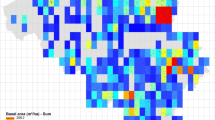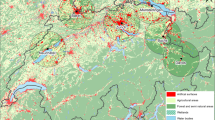Abstract
The purpose of this study was to investigate the relationship between possible long-distance transport of birch pollen and episodes of elevated concentration in Denmark. By analysis of a twenty-six year (1980–2006) time-series of bi-hourly birch pollen counts from two sites (Copenhagen and Viborg) episodes of elevated counts (more than 100 grains) were identified in fewer than 2% of cases. Trajectory analysis showed that such episodes are primarily associated with long-distance transport from Eastern Europe and Scandinavia (43 and 33% of events, respectively); the lowest contribution originated from the British Isles. Long-term episodes (as in 1993 and 2006) occurred when atmospheric conditions favored long-distance transport from several source regions in succession.





Similar content being viewed by others
References
Comtois, P. (1998). Time and space determinants in aerobiology. In Abstracts of the 6th International Congress on Aerobiology, 18–23, Perugia, Italy.
Chenevez, J., Baklanov, A., & Sørensen, J. H. (2004). Pollutant transport schemes integrated in a numerical weather prediction model: Model description and verification results. Meteorological Applications, 11, 265–275.
D’Odorico, P., Yoo, J. C., & Jaeger, S. (2002). Changing seasons: An effect of the north Atlantic Oscillation? Journal of Climate, 15(4), 435–445.
Draxler , R. R. & Rolph, G. D. (2003). HYSPLIT (HYbrid Single-Particle Lagrangian Integrated Trajectory) Model access via NOAA ARL READY Website (http://www.arl.noaa.gov/ready/hysplit4.html). NOAA Air Resources Laboratory, Silver Spring, MD.
Emberlin, J. (1994). The effects of patterns in climate and pollen abundance on allergy. Allergy, 49, 15–20.
Frei, T. (1998). The effects of climate change in Switzerland 1969–1996 on airborne pollen quantities from hazel, birch and grass. Grana, 37, 172–179.
Kapyla, M., & Pentinen, A. (1981). An evaluation of microscopical counting methods of the tape in Hirst-Burkard pollen and spore traps. Grana, 20, 131–141.
Menzel, A. (2000). Trends in phonological phases in Europe between 1951–1996. International Journal of Biometeorology, 44, 76–81.
OECD (2003). Consensus document on the biology of European white birch (Betula pendula Roth). Report Organization for Economic Co-operation and Development (OECD); Environment, Health and Safety Publications, Series on Harmonization of Regulatory Oversight in Biotechnology, N 28, 45 p.
Rasmussen, A. (2002). The effects of climate change on the birch pollen season in Denmark. Aerobiologia, 18, 253–265.
Rolph, G. D. (2003). Real-time environmental applications and display system (READY) Website (http://www.arl.noaa.gov/ready/hysplit4.html). NOAA Air Resources Laboratory, Silver Spring, MD.
Sofiev, M., Siljamo, P., Ranta, H., & Rantio-Lehtimaki, A. (2006). Towards numerical forecasting of long-range air transport of birch pollen: Theoretical considerations and a feasibility study. International Journal of Biometeorology, 50(6), 392–402.
Spieksma, F., Corden, J. M., Detandt, M., Millington, W. M., Nikkels, H., Nolard, N., Schoenmakers, C., Wachter, R., de Weger, L. A., Willems, R., & Emberlin J. (2003). Quantitative trends in annual totals of five common airborne pollen types (betula, quercus, poaceae, urtica and artmisia), at five pollen-monitoring stations in western Europe. Aerobiologica, 19, 171–184.
Viander, M., & Koivikko, A. (1978). The seasonal symptoms of hyposensitized and untreated hay fever patients in relation to birch pollen counts: Correlations with nasal sensitivity, prick tests and RAST. Clinical Allergy, 8, 387–396.
WHO (2003). Phenology and health: Allergic disorders. Report World Health Organization, WHO Meeting, Rome, Italy, 16–17 Jan 2003, 49 p.
Acknowledgments
The authors gratefully acknowledge the Danish Asthma–Allergy Association (AAF) for a long-term cooperation on pollen-related monitoring, research, and forecasting in Denmark. The authors are also grateful to anonymous reviewers for constructive comments and suggestions. The authors gratefully acknowledge the NOAA Air Resources Laboratory (ARL) for provision of the HYSPLIT transport and dispersion model and/or the READY website (http://www.arl.noaa.gov/ready.html) used in this publication. This research activity on birch pollen-related issues and forecasting for Denmark is also a part of the DMI-ENVIRO-HIRLAM system developments and cooperation with the Finish Meteorological Institute (FMI) on the POLLEN project.
Author information
Authors and Affiliations
Corresponding author
Rights and permissions
About this article
Cite this article
Mahura, A.G., Korsholm, U.S., Baklanov, A.A. et al. Elevated birch pollen episodes in Denmark: contributions from remote sources. Aerobiologia 23, 171–179 (2007). https://doi.org/10.1007/s10453-007-9061-3
Received:
Accepted:
Published:
Issue Date:
DOI: https://doi.org/10.1007/s10453-007-9061-3




